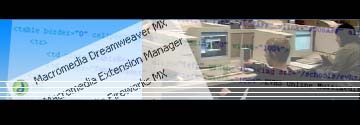|
Making your First Page from Scratch
Create a new web page in Dreamweaver. In the code view, clear out everything
Dreamweaver wrote in there to begin with so you are left with an empty page.
All web pages coded within basic HTML (which is what we are
doing) must begin with an <HTML> tag to let the web page know that the
HTML code will be written from that point. The very last thing on every web
page
must be a </HTML> tag to end the HTML coding. Another tag to put at the
top of your page is the <TITLE> tag. Anything you put in-between the <TITLE> and
</TITLE> tags will display on the top of the browser. It's a good idea
to have one of these on every page for organization and for professionalism.
This is one of the Tips to Design referred to on another
section of our site. Another tag that should be on every web page is the <BODY> tag
(and </BODY at the end). This should always come after your title and before
your real page code starts. The body tag is used for page styling. Some of
its attributes can be will be written about
in later tutorials.
It should
be
closed
off
right before the </HTML> tag is placed. Also,
play with your <b>, <i>, <br>, and <p> tags that you
have also now learned and make a page out of them. Here's an example page I
made that should look
somewhat similar to yours.
| Code Example: |
<HTML>
<TITLE>My First Web Page</TITLE>
<BODY>
<p><b>I'm trying out a little bold text.</b></p>
<p><i>Maybe a little bit of italics now too.</i></p>
<p><b><i>Maybe some of both</i></b></p>
<p>I'll<br>even<br>try<br>some<br>line<br>breaks</p>.
<p>I don't want to forget to end the HTML code!</p>
</BODY>
</HTML> |
| Code Display: |
I'm trying out a little bold text.
Maybe a little bit of italics now too.
Maybe some of both
I'll
even
try
some
line
breaks.
I don't want to forgot to end the HTML code!
|
To test out your page you have just made in the Code view of Dreamweaver,
press the F12 key on your keyboard. This should open up Internet Explorer and
show you what you just coded. You've just coded your first web page. Yay.
Paragraph Alignment
With this section, you will be working with different tag attributes in HTML
coding for the first time. A tag attribute is something added on to a regular
tag (such as <p> in this case) which make it do different things. The
attributes are tagged on to the opening tag, but the closing tag is left alone.
They often involve setting something to = "something". In this case,
we will talk about align attributes that are common in most tags. Here's
a bit of code to demonstrate what these features can do.
| Code Example: |
<p align="left">I'm aligning the text left now, which is the default
orientation.</p>
<p align="center">Now I'm in the middle of the page.</p>
<p align="right">Now I'm on the right side.</p>
|
| Code Display: |
I'm aligning the text left now, which is the default orientation.
Now I'm in the middle of the page.
Now I'm on the right side. |
Back to Page 1 | On to Page 3
|



